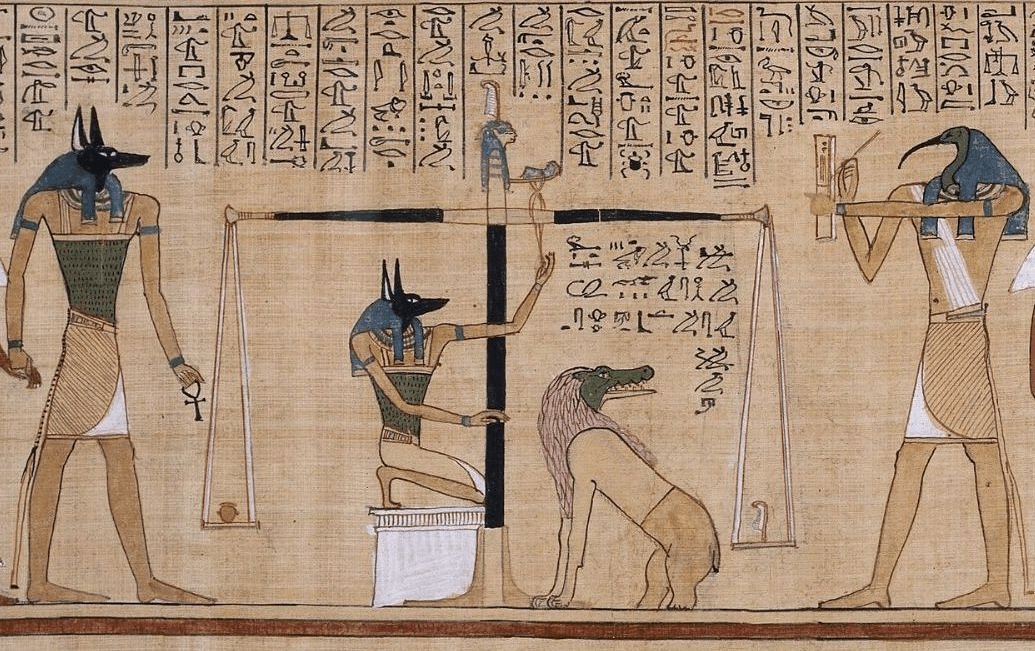Get to Know BP Year One: Ancients
Click the tabs below to learn more about BP Year One.

Egyptian's heart against the Feather of Truth
BP Year One covers World and Biblical History from Creation through the Fall of Rome. Chronologically speaking, it starts with the seven days of Creation, and ends with the demise of the last Western Roman Emperor in AD 476.
On the World History side, Year One starts with the four oldest known civilizations: Egyptian, Sumerian, Harappan and Chinese. It flows from there to the great empires of the Ancient Near East—from Egyptian and Akkadian to Assyrian, Babylonian, Hittite, Persian and more. Then come the Greco-Persian Wars, Classical Greece, the Roman Republic and the Roman Empire. Mixed in are empires and cultures from China, India, the Americas, and Africa beyond Egypt.
On the Biblical History side, Year One covers both the Old Testament and the New. Because the events in the Bible all happened in ancient times, all our Biblical History falls in Year One. Later years cover Church History and Christian missions.

The World History side of BP Year One starts with a short study of archaeology and prehistoric times. Our early weeks focus on the four oldest known civilizations:
- The Egyptian civilization along the Nile River;
- the Sumerian civilization along the Tigris and Euphrates Rivers;
- the Harappan civilization along the Indus River; and
- the Chinese civilization along the Yellow River.
Then come the great empires of the Ancient Near East, from Egyptian to Akkadian, Assyrian, Babylonian, Hittite, Persian and more. One of BP’s priorities is showing how each of these empires interacted with God’s chosen people, the Jews. For example, students learn that King David of Israel grew strong after the Late Bronze Age Collapse—a time when Egypt and Assyria were weak. They also learn that Egypt and Assyria grew strong again just after King Solomon’s day, when Israel split into two kingdoms. The Assyrians finally conquered the northern kingdom, Israel. But they didn’t conquer the southern kingdom, Judah; for by the time Judah fell, the Assyrians had been conquered by the Babylonians—who were then conquered by the Persians!
About halfway through, Year One shifts from the Ancient Near East to lands farther west: first Greece, then Rome. The Greco-Persian Wars make an especially fascinating tale. Then come Classical Greece, the Roman Republic and finally the Roman Empire. Mixed in are stories from ancient China, India, the Americas, and Africa beyond Egypt.

World History topics covered in Year One include:
- Pyramids and ziggurats
- Hieroglyphics and cuneiform
- The Epic of Gilgamesh
- The Code of Hammurabi
- The Fall of Nineveh and the Battle of Carchemish
- Spartan military schools
- Athenian democracy
- The Greco-Persian Wars
- The rise and fall of Alexander the Great
- The founding of Rome
- The switch from Roman Kingdom to Roman Republic
- The Punic Wars
- The rise and fall of Julius Caesar
- Antony and Cleopatra
- The switch from Roman Republic to Roman Empire
- The Fall of the Western Roman Empire
- and many more!
The Biblical History side of BP Year One starts with a slow trip through the Book of Genesis. Week 1 takes a close look at Genesis 1 – 3. We’re still in Genesis for Week 8, where we cover Joseph’s reunion with his father and brothers. Only then do we move on to the Exodus, the Ten Commandments, Joshua, Judges, Ruth, Samuel, Saul and David.
The middle weeks of Year One cover the split kingdoms of Israel and Judah. We study Ahab, Jezebel and Elijah in Week 16; the Fall of Israel in 17; the good King Hezekiah of Judah in 18; and the Fall of Judah in 19. The next three weeks move on to the Babylonian Captivity of the Jews, the return to Jerusalem under Cyrus the Great, and the Book of Esther.
After some weeks off to mark the silence from Malachi to Matthew, our Biblical History picks up again Week 30. We study the New Testament against the backdrop of the Roman Empire, just as we studied the Old Testament against the backdrop of older empires. Chapter 30 covers the birth of Christ, and Chapter 31 His life, death and resurrection. Chapter 33 tackles the Book of Acts and the missionary journeys of the Apostle Paul.

Biblical History topics covered in Year One include:
- The Seven Days of Creation
- The Fall of Mankind
- The Great Flood
- The Tower of Babel
- The three Jewish patriarchs: Abraham, Isaac and Jacob
- Joseph and the Jews’ move to Egypt
- Moses and the Jews’ Exodus from Egypt
- The Conquest of the Promised Land
- The six major Judges: Othniel, Ehud, Deborah, Gideon, Jephthah and Samson
- Ruth, Naomi and Boaz
- The last judge, Samuel
- The first king, Saul
- The most faithful king, David
- The richest king, Solomon
- The split kingdom under Rehoboam and Jeroboam
- The prophets Elijah, Elisha, Isaiah, Jeremiah and more
- The Fall of Israel and the Ten Lost Tribes
- The Fall of Judah and the Babylonian Captivity of the Jews
- Esther, Mordecai and Haman
- The birth, ministry, death and resurrection of Jesus Christ
- The Acts of Apostles and the first Christian martyrs
- and many more!
BP geography goes hand-in-hand with history. Because most of Year One happens around the Mediterranean Sea, most of our geography also centers on the Mediterranean.
Geography topics covered in Year One include:
- The Nile, Tigris and Euphrates Rivers
- The Sea of Galilee, Jordan River and Dead Sea
- Mainland Greece and the Greek islands
- Italy, the Apennines and the Alps
- Iberia and the Pyrenees
- North Africa and the Atlas Mountains
- and many more!

BP Year One is divided into six units:
- Unit 1: Creation and Early Civilizations (6 weeks)
- Unit 2: Egypt, Assyria and Israel (6 weeks)
- Unit 3: Israel Divided; Assyria on Top (6 weeks)
- Unit 4: Greeks versus Persians; the Diaspora (7 weeks)
- Unit 5: The Roman Republic (4 weeks)
- Unit 6: The Roman Empire; the Messiah (5 weeks)
Total: 34 weeks
All BP materials have 34 chapters for a 34-week school year. If you follow a typical 36-week school year, then that leaves two extra weeks for field trips, parties and so on.


